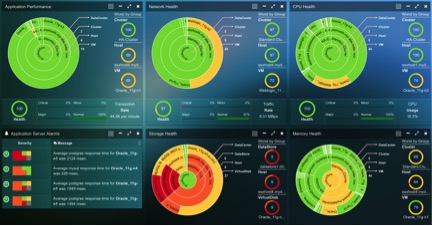Bridging the Gap between Virtual and Physical Infrastructure Management Silos
A server administrator should be able to view all the clusters in a virtualized data center. This should include the following as illustrated in Figure 3: the physical hosts, associated VMs
operating on these hosts as well as the applications that are running on these VMs. With this view, any application performance issue can easily be visualized and tracked to the virtual and
physical infrastructure hosting the application. Key metrics such as response time, transactions per minute, and traffic for each application enables the Server Administrator to proactively
identify performance issues.

Figure 4: A virtualization engineer’s view
A virtualization engineer’s full stack view should consist of key metrics about application performance as well as the virtual and physical compute, storage and network layers that support these applications. This converged visibility that cuts across compute, network and storage domains with contextual metrics across these layers enables the virtualization engineer to spot root causes and resolve application performance issues in the underlying infrastructure very quickly, and to manage the data center with confidence.
A Virtualization Engineer’s View
For the virtualization engineer, the view should include:- Automatically identified applications and service;
- Application and virtualized resource usage and performance heat-map;
- Application service topology;
- Application to infrastructure dependency map; and
- Correlated metrics from application response time to compute, storage and network.
Such a view might look like the one in Figure 4.

Figure 4: A virtualization engineer’s view
A virtualization engineer’s full stack view should consist of key metrics about application performance as well as the virtual and physical compute, storage and network layers that support these applications. This converged visibility that cuts across compute, network and storage domains with contextual metrics across these layers enables the virtualization engineer to spot root causes and resolve application performance issues in the underlying infrastructure very quickly, and to manage the data center with confidence.



















